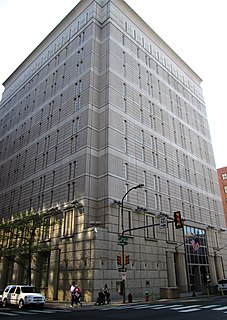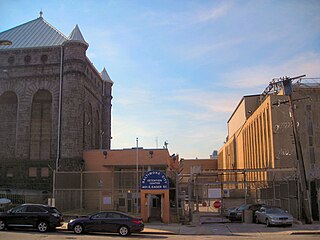The District of Columbia Department of Corrections (DCDC) is a correctional agency responsible for the adult jails and other adult correctional institutions for the District of Columbia, in the United States. [1] DCDC runs the D.C. Jail.
The DOC was first established as an agency in 1946, when the District Jail (built 1872) was combined with the Lorton Correctional Complex. [1] The latter began as a workhouse for male prisoners in 1910, but later expanded to include eight prisons on 3,000 acres (12 km2) of land in Lorton, Fairfax County, Virginia. [1]
In 1999 the DCDC was paying the Virginia Department of Corrections to house 69 prisoners at the Red Onion State Prison. [2]
For about ninety years, the Lorton Correctional Complex in rural Fairfax County, Virginia, about 20 miles south of Washington, served as the District of Columbia's prison. The National Capital Revitalization and Self-Government Improvement Act of 1997 required the DC Department of Corrections to transfer the sentenced felon population formerly housed at Lorton to the Federal Bureau of Prisons (BOP), and the Lorton facility shut down in 2001. [3] The Lorton complex was handed over to the General Services Administration (GSA), which manages property for the federal government, which in turn gave the property to Fairfax County. [3]
The DOC operates the Central Detention Facility (D.C. Jail), at 1901 D Street Southeast. The jail opened in 1976. [4]
In 1985, a federal judge in the case of Campbell v. McGruder, a lawsuit filed against the District of Columbia for unconstitutional jail conditions, set a population cap of 1,674 inmates for the D.C. Jail. [5] This judicially imposed cap was lifted in 2002, after seventeen years. [5] [6] In 2007, DOC administrators set the jail's population capacity at 2,164. [4]
The D.C. Jail houses only adult males. [7] It holds inmates detained while awaiting trial; inmates convicted of misdemeanors; and convicted felons awaiting transfer to the Federal Bureau of Prisons. [8]
The Correctional Treatment Facility (CTF) at 1901 E Street SE, which the district opened in 1992, is an eight-story, medium-security facility located on 10.2 acres (4.1 ha) of land adjacent to the D.C. Jail. It consists of five separate buildings that appear like one large building. [4] It is located adjacent to the D.C. Jail. [4] It houses male prisoners, female prisoners, and juveniles charged as adults. [7] (Juveniles males charged as adults formerly were housed at the D.C. Jail, but this practice was discontinued. [9] ) The CTF is operated by a private contractor, the Corrections Corporation of America, under a twenty-year contract with the District, entered into in March 1997. [4]
The DOC contracts with three privately owned and operated halfway houses: Extended House, Inc., Fairview and Hope Village. The U.S. District Court for the District of Columbia and the Superior Court of the District of Columbia sometimes use the halfway houses as an alternative to incarceration. [4]
Juveniles who are not charged as adults are not in DOC custody, instead going to facilities operated by the Department of Youth Rehabilitation Services.
For fiscal year 2015, DOC reported having 939 full-time employees. [10]
Central Detention Facility

McNeil Island is an island in the northwest United States in south Puget Sound, located southwest of Tacoma, Washington. With a land area of 6.63 square miles (17.2 km2), it lies just north of Anderson Island; Fox Island is to the north, across Carr Inlet, and to the west, separated from Key Peninsula by Pitt Passage. The Washington mainland lies to the east, across the south basin of Puget Sound.

Incarceration in the United States is a primary form of punishment and rehabilitation for the commission of felony and other offenses. The United States has the largest prison population in the world, and the highest per-capita incarceration rate. One out of every 5 people imprisoned across the world is incarcerated in the United States. In 2018 in the US, there were 698 people incarcerated per 100,000; this includes the incarceration rate for adults or people tried as adults. Prison, parole, and probation operations generate an $81 billion annual cost to U.S. taxpayers, with an additional $63 billion for policing. Court costs, bail bond fees, and prison phone fees generate another $38 billion in individual costs.

The Federal Bureau of Prisons (BOP) is a United States federal law enforcement agency under the Department of Justice that is responsible for the care, custody, and control of incarcerated individuals who have committed federal crimes; that is, violations of the United States Code.

The Prison Rape Elimination Act of 2003 (PREA) is the first United States federal law intended to deter the sexual assault of prisoners. The bill was signed into law on September 4, 2003.
Crime in Washington, D.C., is directly related to the city's demographics, geography, and unique criminal justice system. The District's population reached a peak of 802,178 in 1950. Shortly after that, the city began losing residents, and by 1980 Washington had lost one-quarter of its population. The population loss to the suburbs also created a new demographic pattern, which divided affluent neighborhoods west of Rock Creek Park from the less well-off neighborhoods to the east.

CoreCivic, formerly the Corrections Corporation of America (CCA), is a company that owns and manages private prisons and detention centers and operates others on a concession basis. Co-founded in 1983 in Nashville, Tennessee by Thomas W. Beasley, Robert Crants, and T. Don Hutto, it received investments from the Tennessee Valley Authority, Vanderbilt University, and Jack C. Massey, the founder of Hospital Corporation of America.

The Metropolitan Detention Center, Brooklyn is a United States federal administrative detention facility in the Sunset Park neighborhood of Brooklyn, New York City. It holds male and female prisoners of all security levels. It is operated by the Federal Bureau of Prisons, a division of the United States Department of Justice.

The Federal Detention Center is a United States Federal prison in Center City, Philadelphia, Pennsylvania which holds male and female inmates prior to or during court proceedings, as well as inmates serving brief sentences. It is operated by the Federal Bureau of Prisons, a division of the United States Department of Justice.

The Lorton Reformatory, also known as the Lorton Correctional Complex, is a former prison complex in Lorton, Virginia, established in 1910 for the District of Columbia, United States.

The Vernon C. Bain Correctional Center (VCBC), also known as the Vernon C. Bain Maritime Facility and under the nickname "The Boat", is an 800-bed jail barge used to hold inmates for the New York City Department of Corrections. The barge is anchored off the Bronx's southern shore, across from Rikers Island, near Hunts Point. It was built for $161 million at Avondale Shipyard in Louisiana, along the Mississippi River near New Orleans, and brought to New York in 1992 to reduce overcrowding in the island's land-bound buildings for a lower price. Nicknamed "The Boat" by prison staff and inmates, it is designed to handle inmates from medium- to maximum-security in 16 dormitories and 100 cells.

The GEO Group, Inc. (GEO) is a publicly traded C corporation that invests in private prisons and mental health facilities in North America, Australia, South Africa, and the United Kingdom. Headquartered in Boca Raton, Florida, the company's facilities include illegal immigration detention centers, minimum security detention centers, and mental-health and residential-treatment facilities. It also operates government-owned facilities pursuant to management contracts. As of December 31, 2021, the company managed and/or owned 86,000 beds at 106 facilities. In 2019, agencies of the federal government of the United States generated 53% of the company's revenues. Up until 2021 the company was designated as a real estate investment trust, at which time the board of directors elected to reclassify as a C corporation under the stated goal of reducing the company's debt.
Correctional Training Facility (CTF), commonly referenced as Soledad State Prison, is a state prison located on U.S. Route 101, 5 miles (8.0 km) north of Soledad, California, adjacent to Salinas Valley State Prison.
The National Capital Revitalization and Self-Government Improvement Act of 1997, also known as the Revitalization Act, was enacted on August 5, 1997, with provisions to reform the criminal justice system in Washington, D.C. The act was spearheaded by North Carolina Republican Senator Lauch Faircloth.

The Workhouse Arts Center in Lorton, Virginia is a vibrant, 55-acre center for the arts and arts education that, through adaptive reuse, utilizes existing structures on repurposed land in the former Lorton Reformatory. A strong community partner with a growing national reputation, the Workhouse hosts celebrations, offers space for special events, and showcases Fairfax County’s commitment to the arts. The Workhouse is a 501(c)3 non-profit organization and relies on the generosity of WAC partners and community.

The Federal Detention Center, Miami is a prison operated by the Federal Bureau of Prisons. It is located in downtown Miami, at the corner of Northeast Fourth Street and North Miami Avenue. The administrative facility employed 311 staff as of 2002 and housed 1,512 male and female inmates as of July 15, 2010.

Baltimore City Detention Center is a Maryland Department of Public Safety and Correctional Services state prison for men and women. It is located on 401 East Eager Street in downtown Baltimore, Maryland. It has been a state facility since July 1991.
Rivers Correctional Institution is a privately owned prison in unincorporated Hertford County, North Carolina, operated by GEO Group under contract with the Federal Bureau of Prisons since its construction in 2001. The prison, on 257 acres (104 ha) of land, was specially built to house prisoners from the District of Columbia. It is about 1 mile (1.6 km) from the town of Winton and about 200 miles (320 km) from Washington, DC.

The District of Columbia Jail or the D.C. Central Detention Facility is a jail run by the District of Columbia Department of Corrections in Washington, D.C., United States. The Stadium–Armory station serves the D.C. Jail. The majority of male inmates housed in the Central Detention Facility are awaiting adjudication of cases or are sentenced for misdemeanor offenses. Female inmates in the custody of the D.C. Department of Corrections are housed at the adjacent Correctional Treatment Facility. After the National Capital Revitalization and Self-Government Improvement Act of 1997, sentenced felons are transferred to the Federal Bureau of Prisons.
Northeast Ohio Correctional Center is a private medium-security prison for men located in Youngstown, Mahoning County, Ohio, operated by CoreCivic under contract with the United States Marshals Service and the State of Ohio.